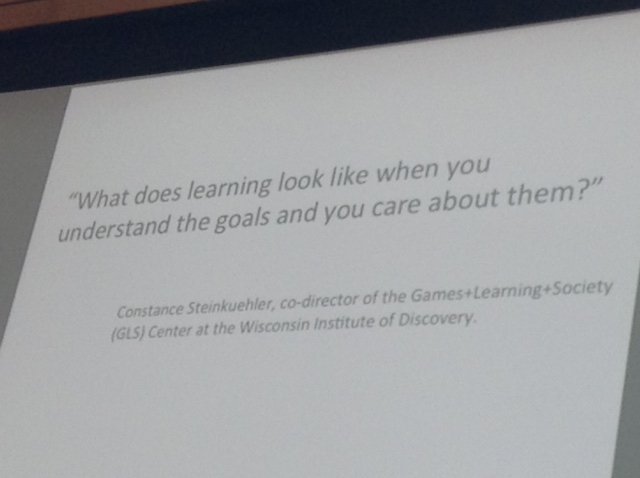Posts Tagged ‘instructional design’
7 Things You Should Know About Developments in Instructional Design
http://www.educause.edu/library/resources/7-things-you-should-know-about-developments-instructional-design
Please read the entire EducCause article here: eli7120
discussion of IMS with faculty:
- pedagogical theories
- learning outcome
- design activities
- students’ multimedia assignments, which lead to online resources
- collaboration with other departments for the students projects
- moving the class to online environment (even if kept hybrid)
What is it?
the complexity of the learning environment is turning instructional design into a more dynamic activity, responding to changing educational models and expectations. Flipped classrooms, makerspaces, and competency-based learning are changing how instructors work with students, how students work with course content, and how mastery is verified. Mobile computing, cloud computing, and data-rich repositories have altered ideas about where and how learning takes place.
How does it work?
One consequence of these changes is that designers can find themselves filling a variety of roles. Today’s instructional designer might work with subject-matter experts, coders, graphic designers, and others. Moreover, the work of an instructional designer increasingly continues throughout the duration of a course rather than taking place upfront.
Who’s doing it?
The responsibility for designing instruction traditionally fell to the instructor of a course, and in many cases it continues to do so. Given the expanding role and landscape of technology—as well as the growing body of knowledge about learning and about educational activities and assessments— dedicated instructional designers are increasingly common and often take a stronger role.
Why is it significant?
The focus on student-centered learning, for example, has spurred the creation of complex integrated learning environments that comprise multiple instructional modules. Competency-based learning allows students to progress at their own pace and finish assignments, courses, and degree plans as time and skills permit. Data provided by analytics systems can help instructional designers predict which pedagogical approaches might be most effective and tailor learning experiences accordingly. The use of mobile learning continues to grow, enabling new kinds of learning experiences.
What are the downsides?
Given the range of competencies needed for the position, finding and hiring instructional designers who fit well into particular institutional cultures can be challenging to the extent that instructors hand over greater amounts of the design process to instructional designers, some of those instructors will feel that they are giving up control, which, in some cases, might appear to be simply the latest threat to faculty authority and autonomy. My note: and this is why SCSU Academic Technology is lead by faculty not IT staff.
Where is it going?
In some contexts, instructional designers might work more directly with students, teaching them lifelong learning skills. Students might begin coursework by choosing from a menu of options, creating their own path through content, making choices about learning options, being more hands-on, and selecting best approaches for demonstrating mastery. Educational models that feature adaptive and personalized learning will increasingly be a focus of instructional design. My note: SCSU CETL does not understand instructional design tendencies AT ALL. Instead of grooming faculty to assume the the leadership role and fill out the demand for instructional design, it isolates and downgrades (keeping traditional and old-fashioned) instructional design to basic tasks of technicalities done by IT staff.
What are the implications for teaching and learning?
By helping align educational activities with a growing understanding of the conditions,
tools, and techniques that enable better learning, instructional designers can help higher education take full advantage of new and emerging models of education. Instructional
designers bring a cross-disciplinary approach to their work, showing faculty how learning activities used in particular subject areas might be effective in others. In this way, instructional
designers can cultivate a measure of consistency across courses and disciplines in how educational strategies and techniques are incorporated. Designers can also facilitate the
creation of inclusive learning environments that offer choices to students with varying strengths and preferences.
More on instructional design in this IMS blog:
https://blog.stcloudstate.edu/ims/2014/10/13/instructional-design/
Academy of distinguished teachers, Innovation
University of Minnesota, McNamara Alumni Center – Twin Cities Campus. April 8, 2015
Full program available here: https://guidebook.com/g/adt/

Randy Bass
Randy Bass
https://www.linkedin.com/pub/randall-bass/14/94/77
flipping disruption into Design
there are two type of universities: the ones that are in control of change and the ones, which are pressed to change.
what kind of education is needed at this moment of history.
Assumptions: 5-10 years will be for a first time outcompeted in terms of delivering information and degrees. What is that the university can do distinctively well that WWW cannot do: mentored learning and the arc of learning (beyond collection of granular separate learning)
book: The New Division of Labor. http://www.amazon.com/The-New-Division-Labor-Computers/dp/0691124027
External forces of potential disruption: 1. MOOCs, nearly free education, 2. skilled-based learning (Codeacademy, Udacity), 3. data analytic 4. public pressure on access, metrics of impact.
Gartner group (http://www.gartner.com/technology/home.jsp) hype cycle : overvalued in a short term and undervalued in a long term. MOOC is excellent example.
NMC: competing models of education.
learning analytics. adaptive learning, intelligent tutoring etc. Open Learning Initative. http://oli.cmu.edu/
In the 19th century, railroads companies which were in the business of railroad companies went under; the ones which were in the business of transportation survived. Parallel, universities, which are in the business of delivering information will die out; the ones, which will survive must look to a very different picture.

formative wider outcomes
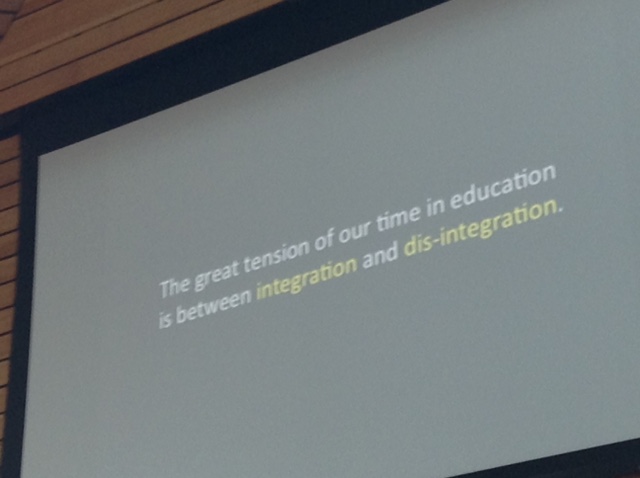
integration and dis-integration
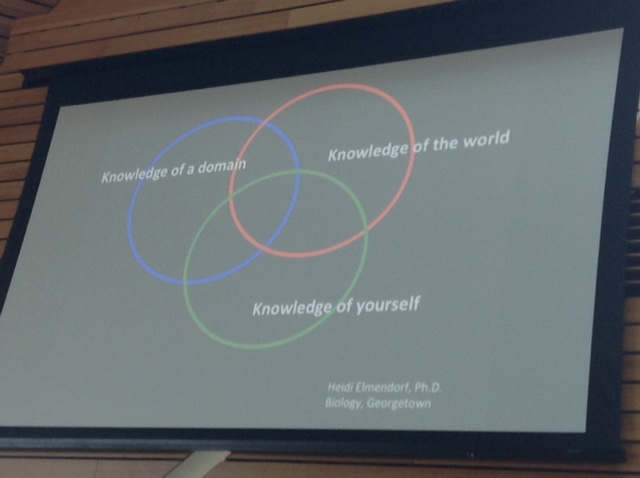
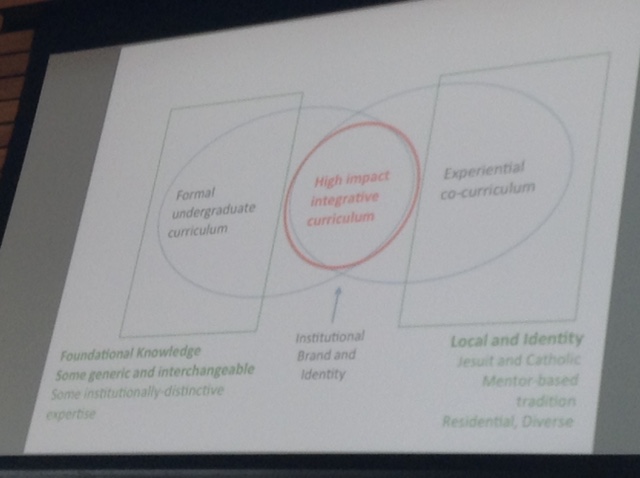
high impact integrative curriculum

what makes high inpact practices high impact
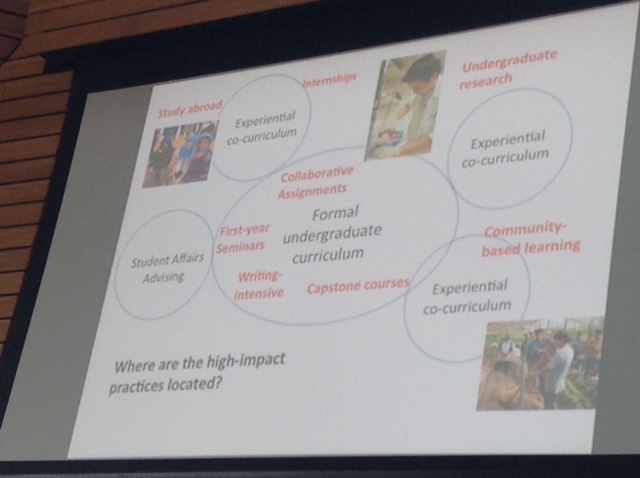
formal versus informal
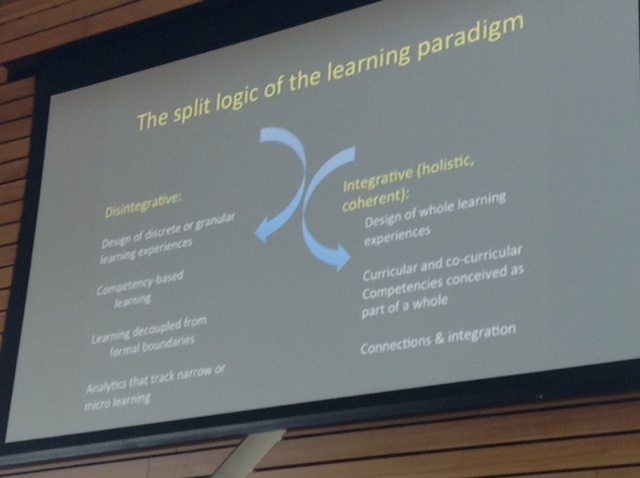
Selected sessions:
The Value of Assessing Outcomes of Teaching Methodologies to guide instructional design
https://guidebook.com/guide/33541/event/10594685/
game-based learning:
Upping your Game – Best Practices in Using Game-Based Learning
https://guidebook.com/guide/33541/event/10594684/
Implementing Game Dynamics in Moodle
https://guidebook.com/guide/33541/event/10693434/
visuals:
Engaging Students through Video Integration
https://guidebook.com/guide/33541/event/10676389/
https://guidebook.com/guide/33541/event/10676375/
Using Flipgrid Video Commentary to Share Student Learning
https://guidebook.com/guide/33541/event/10676361/
————
Enhancing learning with online narrated presentations using VoiceThread
https://guidebook.com/guide/33541/event/10676372/
flipped:
Essential Technology & Tools for Flipping Your Classroom
https://guidebook.com/guide/33541/event/10676385/
Improving Delivery of Technical Course Content through Incremental Use of Classroom “Flipping”
https://guidebook.com/guide/33541/event/10676376/
https://guidebook.com/guide/33541/event/10594850/
The Pros and Cons of Flipping the Classroom
https://guidebook.com/guide/33541/event/10676323/
Using Google Forms for Student Group Evaluations
https://guidebook.com/guide/33541/event/10734863/
Library:
The University Libraries Partnership for Affordable Content – Enhance Student Learning and Save Them Money!
https://guidebook.com/guide/33541/event/10676358/
CRS Tophat:
Using Classroom Debates as an Interactive Learning Tool in a Course on Companion Animal Ethical Issues
https://guidebook.com/guide/33541/event/10676369/
online:
Adapting the Harvard Case Method for Online Courses
https://guidebook.com/guide/33541/event/10595018/
Readiness Assessment for Online Courses
https://guidebook.com/guide/33541/event/10595040/

technology showcase general view
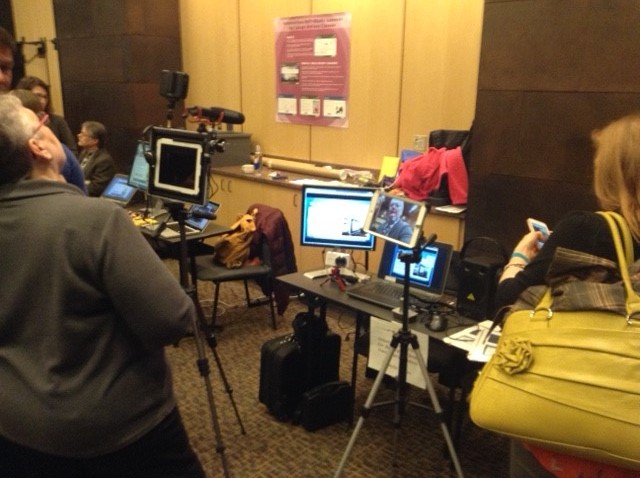
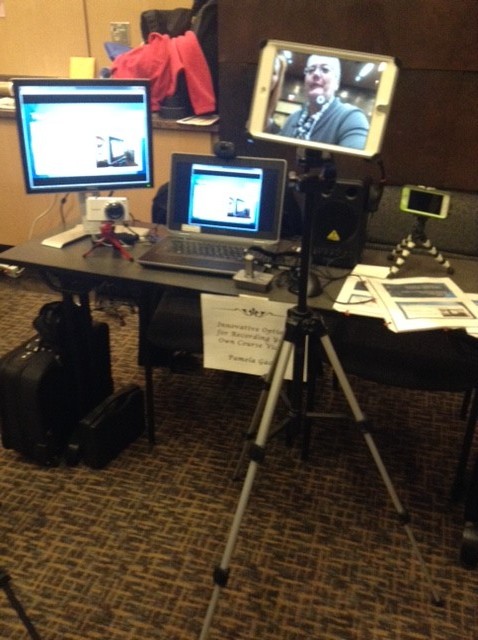
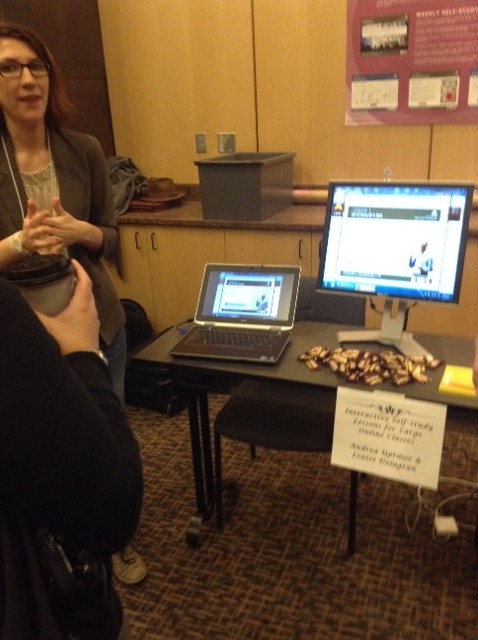


The Science of Happy Design – SXSW 2015 from Pamela Pavliscak
The 2015 Teaching Professor Conference is the place to hear about the latest pedagogical strategies.
The cut-off date for submitting a proposal to the
2015 Teaching Professor Conference is approaching fast!
All proposals must be submitted by October 31, 2014.
The Teaching Professor Conference is known for attracting a roster of high-quality, engaging presenters; that’s why we’re asking you to be a part of next year’s event. If you have previously submitted a proposal for past conferences, we sincerely ask you to submit again. And if you have never submitted a proposal for a session or poster session, we ask that you seriously consider this opportunity to share your expertise at the conference.
The 12th annual Teaching Professor Conference will be held May 29-31, 2015 at the Sheraton Atlanta Hotel, Atlanta, GA.
Featured topical areas are:
Topical Area 1: Instructional Design
Topical Area 2: Activities that Engage Students
Topical Area 3: Teaching Specific Types of Students
Topical Area 4: Instructional Vitality: Ways to Keep Teaching Fresh and Invigorated
Topical Area 5: Teaching and Learning with Technology
Topical Area 6: Creating Climates for Learning
Topical Area 7: Faculty Development
For more information about the proposal process and how to submit your proposal, please click here: http://www.teachingprofessor.com/conference/proposals.
The Teaching Professor Conference is three intensive days of plenary sessions, preconference workshops, sessions, poster sessions, and more. Here is your chance to be a part of it in 2015.
Deadline for proposal submissions is Friday, October 31st, 2014.
free ebook available PDF, EPUB, and MOBI formats. Complete the form and download the eBook today!
61 Tips for Making Learning Memorable with Graphics and Visual Design
September 23, 2014
Contributing Editor, Karen Forni
http://teacherswithapps.com/10-design-questions-marzano-will-improve-teaching/
In The Art and Science of Teaching: A Comprehensive Framework for Effective Instruction, author Robert J. Marzano presents a model for ensuring quality teaching that balances the necessity of research-based data with the equally vital need to understand the strengths and weaknesses of individual students.
the basis of the ten design questions are to be used by teachers to plan effective units and lessons as well as execute them. Remember what works well with one child may not with another.
1.What will I do to establish and communicate learning goals, track student progress, and celebrate success?
2. What will I do to help students effectively interact with new knowledge?
3. What will I do to help students practice and deepen their understanding of new knowledge?
4. What will I do to help students generate and test hypotheses about new knowledge?
5. What will I do to engage students?
6. What will I do to establish or maintain classroom rules and procedures?
7. What will I do to recognize and acknowledge adherence and lack of adherence to classroom rules and procedures?
8. What will I do to establish and maintain effective relationships with students?
9. What will I do to communicate high expectations for all students?
10. What will I do to develop effective lessons organized into a cohesive unit?
What does an Instructional Designer do?
Would you like to discuss designing course materials or entire course?
Please contact us:
InforMedia Services
informedia@stcloudstate.edu
pmiltenoff@stcloudstate.edu
trhergert@stcloudstate.edu
Contact us via social media:
IMS blog: https://blog.stcloudstate.edu/ims/
Twitter: https://twitter.com/SCSUtechinstruc
Facebook: https://www.facebook.com/InforMediaServices?ref=hl
Pinterest: http://www.pinterest.com/scsutechnology/
Instagram: http://instagram.com/scsutechinstruct
YouTube: https://www.youtube.com/channel/UC_UMIE5r6YB8KzTF5nZJFyA
Google +: https://plus.google.com/u/0/115966710162153290760/posts/p/pub
LinkedIn: https://www.linkedin.com/in/scsuinstructionaltechnology
per LinkedIn discussion: http://www.linkedin.com/groupAnswers?viewQuestionAndAnswers=&discussionID=5822757351727316994&gid=2038260&goback=%2Enmp_*1_*1_*1_*1_*1_*1_*1_*1_*1_*1#commentID_null
What is the difference between education and training?
Don Fitchett☆☆☆☆☆ Industrial Automation Training – Industrial Training software to Maintenance, Engineering, Manufacturing.Top Contributor
Schools and companies commonly use the word “Training” when actually all they are delivering is scholastic education. Our company clearly distinguishes between the two which increases our effectiveness and to differentiate what we deliver to customers (what most call students) from others like colleges. I thought it would be interesting to get this group’s members opinion on the difference between “Training” and “Education”, and to get group members thinking about it.
 ray schroeder
ray schroeder
Karagiorgi, Y., & Symeou, L. (2005). Translating Constructivism into Instructional Design: Potential and Limitations. Journal of Educational Technology & Society, 8(1), 17–27.
p. 18 Knowledge for constructivism cannot be imposed or transferred intact from the mind of one knower to the mind of another. Therefore, learning and teaching cannot be synonymous: we can teach, even well, without having students learn
p. 19 In the traditional approach, the instructional designer analyses the conditions – such as the content, the learner, and the instructional setting – which bear on the instructional system, in preparation for the specification of intended learning outcomes. In the constructivist approach, the instructional content cannot be pre-specified. Constructivist designers avoid the breaking down of context into component parts as traditional instructional designers do, but are in favour of environments in which knowledge, skills, and complexity exist naturally.
The goal, for instance, is not to teach a particular version of history, but to teach someone how to think like a historian.
p. 19 In traditional instruction, this phase involves the design of a sequence to achieve specified performance objectives.
Yiasemina Karagiorgi



